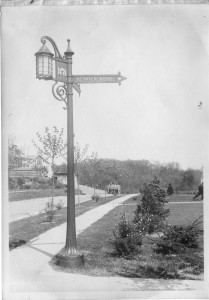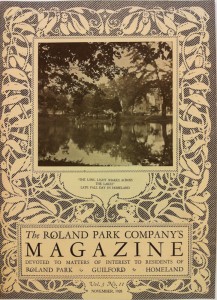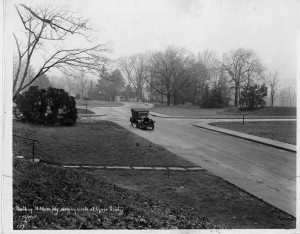This is the final entry in a monthly series of posts highlighting uncovered items of note, and the archival process brought to bear on these items, as we preserve, arrange, and describe the Roland Park Company Archives.
 Well everyone, it’s been a long journey, and so it is with great pleasure that I can announce that the Roland Park Company records are now open for research! Click here to see the finding aid for this collection, officially called MS 504 – The Roland Park Company records.
Well everyone, it’s been a long journey, and so it is with great pleasure that I can announce that the Roland Park Company records are now open for research! Click here to see the finding aid for this collection, officially called MS 504 – The Roland Park Company records.
Please note that the architectural drawings remain closed for conservation reasons.
What now? Well, come on down! Everything you need to know to use and visit the collection is available here, including our hours, directions, and the email address you’ll need to request materials in advance (or ask questions).
Some facts about the collection and how to use it:
- The records date from 1865 to 1970, but the real bulk of the material dates from the company’s founding in 1891 to one year after its liquidation on December 31, 1959 (so to 1960).
 The records consist of all kinds of material. The vast bulk (and I do mean vast) is correspondence, but there are also ledgers, scrapbooks, photographs, reports, meeting minutes, subject files on particular topics (like national real estate policies), and published material (like the Roland Park Company Magazine).
The records consist of all kinds of material. The vast bulk (and I do mean vast) is correspondence, but there are also ledgers, scrapbooks, photographs, reports, meeting minutes, subject files on particular topics (like national real estate policies), and published material (like the Roland Park Company Magazine).- The correspondence is not only the biggest part of the collection, but also the most complex. Remember the Paper Database parts 1 and 2? To help explain that a little more, check out pages 8-10 in the finding aid. I tried to explain the correspondence numbering system as well as I could, but the best way to figure it out is to dive right in.
- There are practically three collections in the Roland Park Company records! In addition to the company records, there are also the papers of its two presidents, Edward H. Bouton and John M. Mowbray. Take a look at the table of contents in the finding aid and you’ll see they’ve been separated into their own series for you. These were very interesting men, and they had an influence on housing policies in the United States.
- The records are in 298 boxes, not counting the architectural drawings (which remain closed for conservation reasons), and almost all of them are housed off-site. Special Collections will require at least 24 hours’ notice to get these to you, so make sure you email us.
- The Roland Park Company records finding aid, which is the document that you researchers will be using in order to see what’s actually in the collection, is a whopping 484 pages long! Yes, that’s long, and boy are my fingers tired.
- The Roland Park Company had 20 subsidiary companies! Check out page 408 of the finding aid for a helpful chronology of when all these smaller companies were founded, and the various names they were known by.

So I hope you have enjoyed reading about the journey. The best is yet to come now that we can hand the work over to you, researchers of the world, to help these records tell their story to us all.

I would like to look at photographs and drawings of Roland park residences from the first two decades of the twentieth century . I am restoring a 1904 home on Ridgewood Road and any materials showing inside and exterior views would be appreciated . Also information concerning the interior and exterior paint and stain colors used during those years would be most helpful.Many thanks.